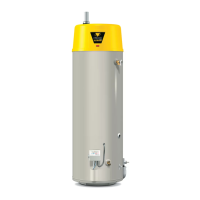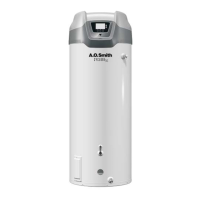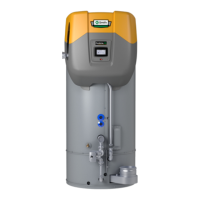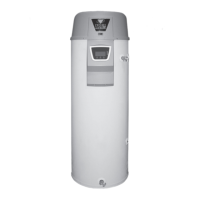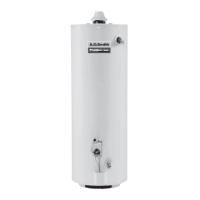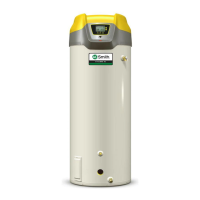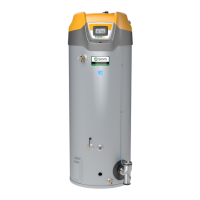21
U.S. INSTALLATIONS:
NOTE: This unit can be vented with PVC pipe materials
(DWV ASTM-D2665 or CSA B181.2; Schedule 40, 80, 120
ASTM-D1785 or CSA B137.3; or SDR Series ASTM-D2241 or
CSA B137.3), CPVC pipe materials (CPVC41 ASTM-D2846
or CSA B137.6; Schedule 40, 80 ASTM-F441 or CSA B137.6;
or SDR Series ASTM-F442), ABS pipe materials (Schedule
40 DWV ASTM-D2661 or CSA B181.1. The ttings, other than
the TERMINATION should be equivalent to PVC-DWV ttings
meeting ASTM D-2665 (Use CPVC ttings, ASTM F-438 for
CPVC pipe and ABS ttings, ASTM D-2661/3311 for ABS pipe).
If CPVC or ABS pipe and ttings are used, then proper cement
must be used for all joints, including joining the pipe to Termination
(PVC Material). If local codes do not allow the use of the PVC
termination when a material other than PVC is used for venting,
then an equivalent tting of that material may be substituted if
the screen in the PVC terminal is removed and inserted into the
new tting.
CANADIAN INSTALLATIONS:
Installation of this water heater must comply with the
current edition CAN/CSA B149.1 - Natural Gas and Propane
Installation Code which requires the vent system components
be certied to ULC S636.
This water heater has been design certied to be vented with
PVC pipe certied and marked as complying with ULC S636.
This water heater is supplied with a 2 inch termination elbow
that is a special tting that must be used with the appliance. Any
outlet piping, ttings and glue used to vent this appliance that
is not supplied by the manufacturer must comply with the ULC
S636 requirements.
PVC Materials should use ASTM D-2564 Grade Cement; CPVC
Materials should use ASTM F-493 Grade Cement and ABS
Materials should use ASTM D-2235 Grade Cement.
If the water heater is being installed as a replacement for an
existing power vented heater in pre-existing venting, a thorough
inspection of existing venting system must be performed prior
to any installation work. Verify that correct material as detailed
above has been used, and that the minimum or maximum vent
lengths and terminal location as detailed in this manual have been
met. Carefully inspect the entire venting system for any signs of
cracks or fractures, particularly at joints between elbows and
other ttings and straight runs of vent pipe. Check system for signs
of sagging or other stresses in joints as a result of misalignment
of any components in the system. If any of these conditions are
found, they must be corrected in accordance with the venting
instructions in this manual before completing installation and
putting the water heater into service.
NOTE:
For water heaters in locations with high ambient
temperatures above 100°F (38°C) it is recommended that CPVC
or ABS pipe and ttings be used.
4. All vent (exhaust) pipes must be pitched a minimum of a 1/4” per
foot back to the water heater to allow drainage of condensation.
INSTALLATION OF VENT SYSTEM
Before beginning installation of piping system thoroughly read the
section of this manual VENT PIPE PREPARATION.
If you are installing your system so that it vents through roof,
please refer to section titled INSTALL ATION OF VERTICAL VENT
SYSTEM.
VENT TERMINAL INSTALLATION, SIDEWALL
1. Install the vent terminal by using the cover plate as a template
to mark the hole for the vent pipe to pass through the wall.
BEWARE OF CONCEALED WIRING AND PIPING INSIDE THE
WALL.
2. If the Vent Terminal is being installed on the outside of a nished
wall, it may be easier to mark both the inside and outside wall.
Align the holes by drilling a hole through the center of the
template from the inside through to the outside. The template
can now be positioned on the outside wall using the drilled hole
as a centering point for the template.
3. A) MASONRY SIDE WALLS
Chisel an opening approximately one half inch (1.3 cm) larger
than the marked circle.
B) WOODEN SIDE WALLS
Drill a pilot hole approximately one quarter inch (0.64 cm) outside
of the marked circle. This pilot hole is used as a starting point
for a saws-all or sabre saw blade. Cut around the marked circle
staying approximately one quarter inch (0.64 cm) outside of the
line. (This will allow the vent to easily slide through the opening.
The resulting gap will be covered up by the Vent Terminal cover
plate.) Repeat this step on inside wall if necessary.

